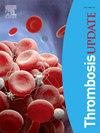Long-term survival and cerebrovascular events after carotid artery stenting in patients with chronic kidney disease
Q4 Medicine
引用次数: 0
Abstract
Objective
Chronic kidney disease (CKD) is associated with cerebrovascular diseases (CVDs) due to chronic systemic inflammation. This study aimed to estimate perioperative and long-term outcomes in Chinese patients undergoing carotid artery stenting (CAS) who had different stages of CKD.
Method
This retrospective study enrolled 888 patients undergoing CAS for carotid artery stenosis. Patients were classified into normal, mild, moderate, and severe CKD and dialysis groups based on their renal function. The primary endpoint was long-term survival from a major adverse event (MAE), which was predefined as the development of a stroke, myocardial infarction (MI), or death during a 10-year long-term follow-up.
Results
Perioperative rates for MAE were 1.5 %, 1.8 %, 3.0 %, 10.3 %, and 9.1 % for the five categories (p < 0.001). There was no death within the perioperative 30 days. The estimated 5-year death-free survival rates decreased with worsening renal function (92.2 % vs. 82.7 % vs. 76.9 % vs. 61.4 % vs. 58.6 %, p < 0.001). The long-term MAE-free survival was 94.7 % vs. 91.0 % vs. 80.2 % vs. 63.7 % vs. 52.2 % for the groups, with the differences being significant between normal to moderate CKD and severe CKD and hemodialysis-dependent cases. Cox regression analysis revealed that dialysis (HR = 3.216 (95%CI: 1.662, 6.223), p = 0.001), severe CKD (HR = 4.592 (95%CI: 2.348, 8.982), p < 0.001), hypertension (HR = 1.977 (95%CI: 1.292, 3.024), p = 0.002), coronary artery disease (HR = 1.509 (95%CI: 1.037, 2.196), p = 0.032) and diabetes mellitus (HR = 2.459 (95%CI: 1.482, 4.079), p < 0.001) were predictors of long-term MAE after CAS.
Conclusion
Risk of perioperative and long-term MAE increased with CKD severity. Patients with normal to moderate CKD benefited from MAE-free survival after CAS. However, preventive CAS appeared to be inappropriate in severe CKD or hemodialysis cases with asymptomatic carotid stenosis, particularly in those with a number of comorbidities.
慢性肾病患者颈动脉支架置入术后的长期生存和脑血管事件
目的慢性肾脏疾病(CKD)与脑血管疾病(cvd)相关,是慢性全身性炎症所致。本研究旨在评估中国不同阶段CKD患者行颈动脉支架植入术(CAS)的围手术期和远期预后。方法回顾性研究888例颈动脉狭窄患者。根据肾功能将患者分为正常、轻度、中度、重度CKD和透析组。主要终点是主要不良事件(MAE)的长期生存,在10年的长期随访中,主要不良事件被定义为中风、心肌梗死(MI)或死亡。结果5类MAE的手术成功率分别为1.5%、1.8%、3.0%、10.3%、9.1% (p <;0.001)。围手术期30天内无死亡病例。估计的5年无死亡生存率随着肾功能恶化而下降(92.2% vs. 82.7% vs. 76.9% vs. 61.4% vs. 58.6%, p <;0.001)。两组患者的长期无mae生存率分别为94.7% vs. 91.0% vs. 80.2% vs. 63.7% vs. 52.2%,其中正常至中度CKD和重度CKD以及血液透析依赖患者之间的差异具有统计学意义。Cox回归分析显示,透析组(HR = 3.216 (95%CI: 1.662, 6.223), p = 0.001),重度CKD组(HR = 4.592 (95%CI: 2.348, 8.982), p <;0.001)、高血压(HR = 1.977 (95%CI: 1.292, 3.024), p = 0.002)、冠状动脉疾病(HR = 1.509 (95%CI: 1.037, 2.196), p = 0.032)、糖尿病(HR = 2.459 (95%CI: 1.482, 4.079), p <;0.001)是CAS术后长期MAE的预测因子。结论随CKD严重程度的增加,围手术期和远期MAE的发生风险增加。正常至中度CKD患者受益于CAS后的无mae生存期。然而,预防性CAS似乎不适合严重CKD或无症状颈动脉狭窄的血液透析患者,特别是那些有许多合并症的患者。
本文章由计算机程序翻译,如有差异,请以英文原文为准。
求助全文
约1分钟内获得全文
求助全文

 求助内容:
求助内容: 应助结果提醒方式:
应助结果提醒方式:


